您可以使用以下方法在 MongoDB 中查询数组:
您的编程语言的驱动程序。
MongoDB Atlas 用户界面。要了解更多信息,请参阅使用 MongoDB Atlas 查询数组。
➤ 使用右上角的 Select your language(选择语言)下拉菜单,设置以下示例的语言或选择 MongoDB Compass。
本页提供了使用 mongosh 中的 db.collection.find() 方法对数组字段进行查询操作的示例。
此页面上的示例使用的是 inventory 集合。连接到 MongoDB 实例中的测试数据库,然后创建 inventory 集合:
本页提供的示例说明如何使用 MongoDB Compass 对数组字段执行查询操作。
此页面上的示例使用的是 inventory 集合。连接到 MongoDB 实例中的测试数据库,然后创建 inventory 集合:
本页提供了使用 mongoc_collection_find_with_opts 对大量字段进行查询操作的示例。
此页面上的示例使用的是 inventory 集合。连接到 MongoDB 实例中的测试数据库,然后创建 inventory 集合:
本页提供的示例展示了使用MongoDB C#驱动程序中的 MongoCollection.Find() 方法对大量字段查询操作。
此页面上的示例使用的是 inventory 集合。连接到 MongoDB 实例中的测试数据库,然后创建 inventory 集合:
本页面提供了使用 MongoDB Go 驱动程序 中的 Collection.Find 函数对数组字段进行查询操作的示例。
此页面上的示例使用的是 inventory 集合。连接到 MongoDB 实例中的测试数据库,然后创建 inventory 集合:
本页提供了使用 com.mongodb.reactivestreams 对大量字段进行查询操作的示例。 MongoDB Java Reactive Streams 驱动程序中的客户端方法。
此页面上的示例使用的是 inventory 集合。连接到 MongoDB 实例中的测试数据库,然后创建 inventory 集合:
本页提供了使用 com.mongodb 对大量字段进行查询操作的示例。 MongoDB Java同步驱动程序中的客户端方法。
提示
此驱动程序提供了 com.mongodb.client.model.Filters 辅助方法,以便于创建筛选器文档。此页面中的示例使用这些方法创建筛选器文档。
此页面上的示例使用的是 inventory 集合。连接到 MongoDB 实例中的测试数据库,然后创建 inventory 集合:
本页提供了使用MongoCollection.find()对大量字段进行查询操作的示例。MongoDB Kotlin协程驱动程序中的方法。
提示
此驱动程序提供了 com.mongodb.client.model.Filters 辅助方法,以便于创建筛选器文档。此页面中的示例使用这些方法创建筛选器文档。
此页面上的示例使用的是 inventory 集合。连接到 MongoDB 实例中的测试数据库,然后创建 inventory 集合:
自 2025 年 5 月 14 日起,Motor 已被弃用,转而使用 PyMongo 库中的 PyMongo Async API GA 版本。在 2026 年 5 月 14 日终止生命周期之前,我们不会为其添加新功能,只会提供错误修复。之后,我们将仅修复关键错误,直到 2027 年 5 月 14 日最终支持结束。在 Motor 仍受支持期间,我们强烈建议迁移至 PyMongo Async API。
有关迁移的更多信息,请参阅 PyMongo 文档中的迁移到 PyMongo Async 指南。
本页面提供了使用 PyMongopymongo.asynchronous.collection.AsyncCollection.find Async API 中的 方法对大量字段查询操作的示例。
此页面上的示例使用的是 inventory 集合。连接到 MongoDB 实例中的测试数据库,然后创建 inventory 集合:
本页提供了使用 Collection.find() 对大量字段进行查询操作的示例。MongoDB Node.js驱动程序中的方法。
此页面上的示例使用的是 inventory 集合。连接到 MongoDB 实例中的测试数据库,然后创建 inventory 集合:
本页面提供的示例展示使用 MongoDB PHP 库中的 MongoDB\\Collection::find() 方法对数组字段执行查询操作。
此页面上的示例使用的是 inventory 集合。连接到 MongoDB 实例中的测试数据库,然后创建 inventory 集合:
本页面提供的示例展示使用 pymongo.collection.Collection.find 方法在 PyMongo Python 驱动程序中对数组字段进行查询操作。
此页面上的示例使用的是 inventory 集合。连接到 MongoDB 实例中的测试数据库,然后创建 inventory 集合:
本页提供了使用 MongoDB Ruby 驱动程序 中的 Mongo::Collection#find() 方法对数组字段执行查询操作的示例。
此页面上的示例使用的是 inventory 集合。连接到 MongoDB 实例中的测试数据库,然后创建 inventory 集合:
本页提供了使用 .find()集合对大量字段进行查询操作的示例MongoDB Scala驱动程序中的方法。
此页面上的示例使用的是 inventory 集合。连接到 MongoDB 实例中的测试数据库,然后创建 inventory 集合:
db.inventory.insertMany([ { item: "journal", qty: 25, tags: ["blank", "red"], dim_cm: [ 14, 21 ] }, { item: "notebook", qty: 50, tags: ["red", "blank"], dim_cm: [ 14, 21 ] }, { item: "paper", qty: 100, tags: ["red", "blank", "plain"], dim_cm: [ 14, 21 ] }, { item: "planner", qty: 75, tags: ["blank", "red"], dim_cm: [ 22.85, 30 ] }, { item: "postcard", qty: 45, tags: ["blue"], dim_cm: [ 10, 15.25 ] } ]);
[ { "item": "journal", "qty": 25, "tags": ["blank", "red"], "dim_cm": [ 14, 21 ] }, { "item": "notebook", "qty": 50, "tags": ["red", "blank"], "dim_cm": [ 14, 21 ] }, { "item": "paper", "qty": 100, "tags": ["red", "blank", "plain"], "dim_cm": [ 14, 21 ] }, { "item": "planner", "qty": 75, "tags": ["blank", "red"], "dim_cm": [ 22.85, 30 ] }, { "item": "postcard", "qty": 45, "tags": ["blue"], "dim_cm": [ 10, 15.25 ] } ]
有关在 MongoDB Compass 中插入文档的说明,请参阅插入文档。
mongoc_collection_t *collection; mongoc_bulk_operation_t *bulk; bson_t *doc; bool r; bson_error_t error; bson_t reply; collection = mongoc_database_get_collection (db, "inventory"); bulk = mongoc_collection_create_bulk_operation_with_opts (collection, NULL); doc = BCON_NEW ( "item", BCON_UTF8 ("journal"), "qty", BCON_INT64 (25), "tags", "[", BCON_UTF8 ("blank"), BCON_UTF8 ("red"), "]", "dim_cm", "[", BCON_INT64 (14), BCON_INT64 (21), "]"); r = mongoc_bulk_operation_insert_with_opts (bulk, doc, NULL, &error); bson_destroy (doc); if (!r) { MONGOC_ERROR ("%s\n", error.message); goto done; } doc = BCON_NEW ( "item", BCON_UTF8 ("notebook"), "qty", BCON_INT64 (50), "tags", "[", BCON_UTF8 ("red"), BCON_UTF8 ("blank"), "]", "dim_cm", "[", BCON_INT64 (14), BCON_INT64 (21), "]"); r = mongoc_bulk_operation_insert_with_opts (bulk, doc, NULL, &error); bson_destroy (doc); if (!r) { MONGOC_ERROR ("%s\n", error.message); goto done; } doc = BCON_NEW ( "item", BCON_UTF8 ("paper"), "qty", BCON_INT64 (100), "tags", "[", BCON_UTF8 ("red"), BCON_UTF8 ("blank"), BCON_UTF8 ("plain"), "]", "dim_cm", "[", BCON_INT64 (14), BCON_INT64 (21), "]"); r = mongoc_bulk_operation_insert_with_opts (bulk, doc, NULL, &error); bson_destroy (doc); if (!r) { MONGOC_ERROR ("%s\n", error.message); goto done; } doc = BCON_NEW ( "item", BCON_UTF8 ("planner"), "qty", BCON_INT64 (75), "tags", "[", BCON_UTF8 ("blank"), BCON_UTF8 ("red"), "]", "dim_cm", "[", BCON_DOUBLE (22.85), BCON_INT64 (30), "]"); r = mongoc_bulk_operation_insert_with_opts (bulk, doc, NULL, &error); bson_destroy (doc); if (!r) { MONGOC_ERROR ("%s\n", error.message); goto done; } doc = BCON_NEW ( "item", BCON_UTF8 ("postcard"), "qty", BCON_INT64 (45), "tags", "[", BCON_UTF8 ("blue"), "]", "dim_cm", "[", BCON_INT64 (10), BCON_DOUBLE (15.25), "]"); r = mongoc_bulk_operation_insert_with_opts (bulk, doc, NULL, &error); bson_destroy (doc); if (!r) { MONGOC_ERROR ("%s\n", error.message); goto done; } /* "reply" is initialized on success or error */ r = (bool) mongoc_bulk_operation_execute (bulk, &reply, &error); if (!r) { MONGOC_ERROR ("%s\n", error.message); }
var documents = new[] { new BsonDocument { { "item", "journal" }, { "qty", 25 }, { "tags", new BsonArray { "blank", "red" } }, { "dim_cm", new BsonArray { 14, 21 } } }, new BsonDocument { { "item", "notebook" }, { "qty", 50 }, { "tags", new BsonArray { "red", "blank" } }, { "dim_cm", new BsonArray { 14, 21 } } }, new BsonDocument { { "item", "paper" }, { "qty", 100 }, { "tags", new BsonArray { "red", "blank", "plain" } }, { "dim_cm", new BsonArray { 14, 21 } } }, new BsonDocument { { "item", "planner" }, { "qty", 75 }, { "tags", new BsonArray { "blank", "red" } }, { "dim_cm", new BsonArray { 22.85, 30 } } }, new BsonDocument { { "item", "postcard" }, { "qty", 45 }, { "tags", new BsonArray { "blue" } }, { "dim_cm", new BsonArray { 10, 15.25 } } } }; collection.InsertMany(documents);
docs := []any{ bson.D{ {"item", "journal"}, {"qty", 25}, {"tags", bson.A{"blank", "red"}}, {"dim_cm", bson.A{14, 21}}, }, bson.D{ {"item", "notebook"}, {"qty", 50}, {"tags", bson.A{"red", "blank"}}, {"dim_cm", bson.A{14, 21}}, }, bson.D{ {"item", "paper"}, {"qty", 100}, {"tags", bson.A{"red", "blank", "plain"}}, {"dim_cm", bson.A{14, 21}}, }, bson.D{ {"item", "planner"}, {"qty", 75}, {"tags", bson.A{"blank", "red"}}, {"dim_cm", bson.A{22.85, 30}}, }, bson.D{ {"item", "postcard"}, {"qty", 45}, {"tags", bson.A{"blue"}}, {"dim_cm", bson.A{10, 15.25}}, }, } result, err := coll.InsertMany(context.TODO(), docs)
Publisher<Success> insertManyPublisher = collection.insertMany(asList( Document.parse("{ item: 'journal', qty: 25, tags: ['blank', 'red'], dim_cm: [ 14, 21 ] }"), Document.parse("{ item: 'notebook', qty: 50, tags: ['red', 'blank'], dim_cm: [ 14, 21 ] }"), Document.parse("{ item: 'paper', qty: 100, tags: ['red', 'blank', 'plain'], dim_cm: [ 14, 21 ] }"), Document.parse("{ item: 'planner', qty: 75, tags: ['blank', 'red'], dim_cm: [ 22.85, 30 ] }"), Document.parse("{ item: 'postcard', qty: 45, tags: ['blue'], dim_cm: [ 10, 15.25 ] }") ));
collection.insertMany(asList( Document.parse("{ item: 'journal', qty: 25, tags: ['blank', 'red'], dim_cm: [ 14, 21 ] }"), Document.parse("{ item: 'notebook', qty: 50, tags: ['red', 'blank'], dim_cm: [ 14, 21 ] }"), Document.parse("{ item: 'paper', qty: 100, tags: ['red', 'blank', 'plain'], dim_cm: [ 14, 21 ] }"), Document.parse("{ item: 'planner', qty: 75, tags: ['blank', 'red'], dim_cm: [ 22.85, 30 ] }"), Document.parse("{ item: 'postcard', qty: 45, tags: ['blue'], dim_cm: [ 10, 15.25 ] }") ));
collection.insertMany( listOf( Document("item", "journal") .append("qty", 25) .append("tags", listOf("blank", "red")) .append("dim_cm", listOf(14, 21)), Document("item", "notebook") .append("qty", 50) .append("tags", listOf("red", "blank")) .append("dim_cm", listOf(14, 21)), Document("item", "paper") .append("qty", 100) .append("tags", listOf("red", "blank", "plain")) .append("dim_cm", listOf(14, 21)), Document("item", "planner") .append("qty", 75) .append("tags", listOf("blank", "red")) .append("dim_cm", listOf(22.85, 30)), Document("item", "postcard") .append("qty", 45) .append("tags", listOf("blue")) .append("dim_cm", listOf(10, 15.25)), ) )
await db.inventory.insert_many( [ {"item": "journal", "qty": 25, "tags": ["blank", "red"], "dim_cm": [14, 21]}, {"item": "notebook", "qty": 50, "tags": ["red", "blank"], "dim_cm": [14, 21]}, { "item": "paper", "qty": 100, "tags": ["red", "blank", "plain"], "dim_cm": [14, 21], }, {"item": "planner", "qty": 75, "tags": ["blank", "red"], "dim_cm": [22.85, 30]}, {"item": "postcard", "qty": 45, "tags": ["blue"], "dim_cm": [10, 15.25]}, ] )
await db.collection('inventory').insertMany([ { item: 'journal', qty: 25, tags: ['blank', 'red'], dim_cm: [14, 21] }, { item: 'notebook', qty: 50, tags: ['red', 'blank'], dim_cm: [14, 21] }, { item: 'paper', qty: 100, tags: ['red', 'blank', 'plain'], dim_cm: [14, 21] }, { item: 'planner', qty: 75, tags: ['blank', 'red'], dim_cm: [22.85, 30] }, { item: 'postcard', qty: 45, tags: ['blue'], dim_cm: [10, 15.25] } ]);
$insertManyResult = $db->inventory->insertMany([ [ 'item' => 'journal', 'qty' => 25, 'tags' => ['blank', 'red'], 'dim_cm' => [14, 21], ], [ 'item' => 'notebook', 'qty' => 50, 'tags' => ['red', 'blank'], 'dim_cm' => [14, 21], ], [ 'item' => 'paper', 'qty' => 100, 'tags' => ['red', 'blank', 'plain'], 'dim_cm' => [14, 21], ], [ 'item' => 'planner', 'qty' => 75, 'tags' => ['blank', 'red'], 'dim_cm' => [22.85, 30], ], [ 'item' => 'postcard', 'qty' => 45, 'tags' => ['blue'], 'dim_cm' => [10, 15.25], ], ]);
db.inventory.insert_many( [ {"item": "journal", "qty": 25, "tags": ["blank", "red"], "dim_cm": [14, 21]}, {"item": "notebook", "qty": 50, "tags": ["red", "blank"], "dim_cm": [14, 21]}, { "item": "paper", "qty": 100, "tags": ["red", "blank", "plain"], "dim_cm": [14, 21], }, {"item": "planner", "qty": 75, "tags": ["blank", "red"], "dim_cm": [22.85, 30]}, {"item": "postcard", "qty": 45, "tags": ["blue"], "dim_cm": [10, 15.25]}, ] )
client[:inventory].insert_many([{ item: 'journal', qty: 25, tags: ['blank', 'red'], dim_cm: [ 14, 21 ] }, { item: 'notebook', qty: 50, tags: ['red', 'blank'], dim_cm: [ 14, 21 ] }, { item: 'paper', qty: 100, tags: ['red', 'blank', 'plain'], dim_cm: [ 14, 21 ] }, { item: 'planner', qty: 75, tags: ['blank', 'red'], dim_cm: [ 22.85, 30 ] }, { item: 'postcard', qty: 45, tags: ['blue'], dim_cm: [ 10, 15.25 ] } ])
collection.insertMany(Seq( Document("""{ item: "journal", qty: 25, tags: ["blank", "red"], dim_cm: [ 14, 21 ] }"""), Document("""{ item: "notebook", qty: 50, tags: ["red", "blank"], dim_cm: [ 14, 21 ] }"""), Document("""{ item: "paper", qty: 100, tags: ["red", "blank", "plain"], dim_cm: [ 14, 21 ] }"""), Document("""{ item: "planner", qty: 75, tags: ["blank", "red"], dim_cm: [ 22.85, 30 ] }"""), Document("""{ item: "postcard", qty: 45, tags: ["blue"], dim_cm: [ 10, 15.25 ] }""") )).execute()
匹配数组
要对数组指定相等条件,请使用查询文档 { <field>: <value> },其中 <value> 是要匹配的精确数组,包括元素的顺序。
要对数组指定相等条件,请使用查询文档 { <field>: <value> },其中 <value> 是要匹配的精确数组,包括元素的顺序。
要对数组指定相等条件,请使用查询文档 { <field>: <value> },其中 <value> 是要匹配的精确数组,包括元素的顺序。
要在大量上指定相等条件,请使用Eq方法构造过滤,其中 <value> 是要匹配的精确大量,包括元素的顺序:
Builders<BsonDocument>.Filter.Eq(<field>, <value>)
要对数组指定相等条件,请使用查询文档 { <field>: <value> },其中 <value> 是要匹配的精确数组,包括元素的顺序。
要对数组指定相等条件,请使用查询文档 eq( <field>, <value>),其中 <value> 是要匹配的精确数组,包括元素的顺序。
要对数组指定相等条件,请使用查询文档 eq( <field>, <value>),其中 <value> 是要匹配的精确数组,包括元素的顺序。
要对数组指定相等条件,请使用查询文档 { <field>: <value> },其中 <value> 是要匹配的精确数组,包括元素的顺序。
要对数组指定相等条件,请使用查询文档 { <field>: <value> },其中 <value> 是要匹配的精确数组,包括元素的顺序。
要对数组指定相等条件,请使用查询文档 { <field>: <value> },其中 <value> 是要匹配的精确数组,包括元素的顺序。
要对数组指定相等条件,请使用查询文档 [ <field> => <value> ],其中 <value> 是要匹配的精确数组,包括元素的顺序。
要对数组指定相等条件,请使用查询文档 { <field>: <value> },其中 <value> 是要匹配的精确数组,包括元素的顺序。
要对数组指定相等条件,请使用查询文档 { <field> => <value> },其中 <value> 是要匹配的精确数组,包括元素的顺序。
要对数组指定相等条件,请使用查询文档 equal( <field>, <value> ),其中 <value> 是要匹配的精确数组,包括元素的顺序。
以下示例查询字段 tags 值是一个数组且恰好有两个元素 "red" 和 "blank"(按指定顺序)的所有文档:
db.inventory.find( { tags: ["red", "blank"] } )
将以下过滤器复制到 Compass 查询栏中,然后单击 Find:
{ tags: ["red", "blank"] }
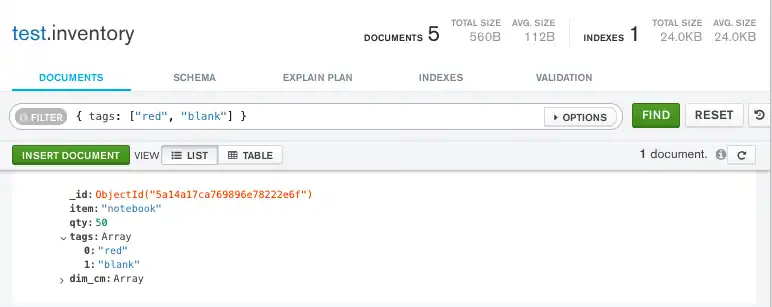
mongoc_collection_t *collection; bson_t *filter; mongoc_cursor_t *cursor; collection = mongoc_database_get_collection (db, "inventory"); filter = BCON_NEW ( "tags", "[", BCON_UTF8 ("red"), BCON_UTF8 ("blank"), "]"); cursor = mongoc_collection_find_with_opts (collection, filter, NULL, NULL);
var filter = Builders<BsonDocument>.Filter.Eq("tags", new[] { "red", "blank" }); var result = collection.Find(filter).ToList();
cursor, err := coll.Find( context.TODO(), bson.D{{"tags", bson.A{"red", "blank"}}}, )
FindPublisher<Document> findPublisher = collection.find(eq("tags", asList("red", "blank")));
FindIterable<Document> findIterable = collection.find(eq("tags", asList("red", "blank")));
val findFlow = collection .find(eq("tags", listOf("red", "blank")))
cursor = db.inventory.find({"tags": ["red", "blank"]})
const cursor = db.collection('inventory').find({ tags: ['red', 'blank'] });
$cursor = $db->inventory->find(['tags' => ['red', 'blank']]);
cursor = db.inventory.find({"tags": ["red", "blank"]})
client[:inventory].find(tags: ['red', 'blank'])
var findObservable = collection.find(equal("tags", Seq("red", "blank")))
相反,如果想查找同时包含 "red" 和 "blank" 元素的数组,而不考虑顺序或数组中的其他元素,则请使用 $all 运算符:
db.inventory.find( { tags: { $all: ["red", "blank"] } } )
将以下过滤器复制到 Compass 查询栏中,然后单击 Find:
{ tags: { $all: ["red", "blank"] } }
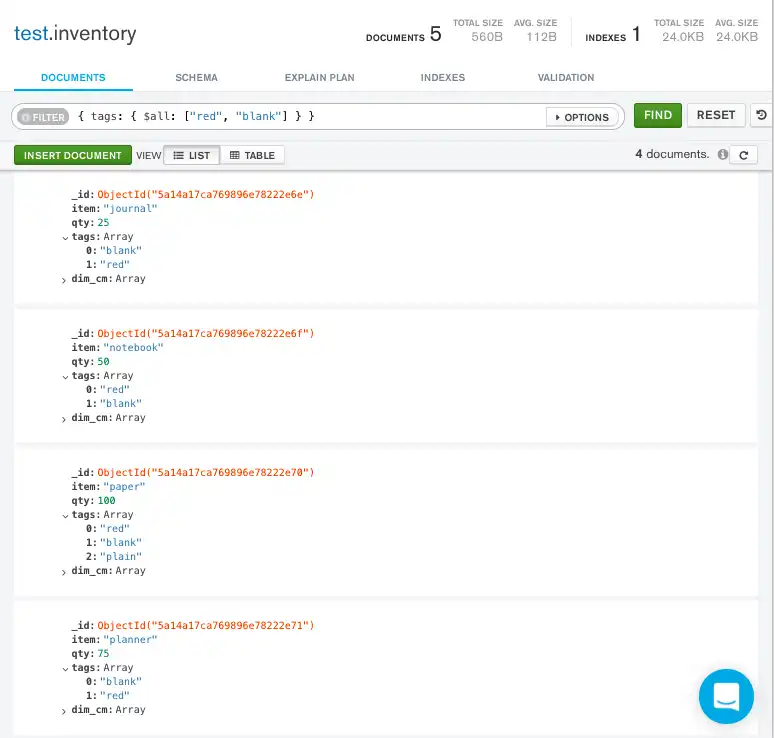
mongoc_collection_t *collection; bson_t *filter; mongoc_cursor_t *cursor; collection = mongoc_database_get_collection (db, "inventory"); filter = BCON_NEW ( "tags", "{", "$all", "[", BCON_UTF8 ("red"), BCON_UTF8 ("blank"), "]", "}"); cursor = mongoc_collection_find_with_opts (collection, filter, NULL, NULL);
var filter = Builders<BsonDocument>.Filter.All("tags", new[] { "red", "blank" }); var result = collection.Find(filter).ToList();
cursor, err := coll.Find( context.TODO(), bson.D{ {"tags", bson.D{{"$all", bson.A{"red", "blank"}}}}, })
findPublisher = collection.find(all("tags", asList("red", "blank")));
findIterable = collection.find(all("tags", asList("red", "blank")));
val findFlow = collection .find(all("tags", listOf("red", "blank")))
cursor = db.inventory.find({"tags": {"$all": ["red", "blank"]}})
const cursor = db.collection('inventory').find({ tags: { $all: ['red', 'blank'] } });
$cursor = $db->inventory->find(['tags' => ['$all' => ['red', 'blank']]]);
cursor = db.inventory.find({"tags": {"$all": ["red", "blank"]}})
client[:inventory].find(tags: { '$all' => ['red', 'blank'] })
findObservable = collection.find(all("tags", "red", "blank"))
查询数组元素
要查询数组字段是否至少包含一个具有指定值的元素,请使用筛选器 { <field>: <value> },其中的 <value> 是元素值。
要查询数组字段是否至少包含一个具有指定值的元素,请使用筛选器 { <field>: <value> },其中的 <value> 是元素值。
要查询数组字段是否至少包含一个具有指定值的元素,请使用筛选器 { <field>: <value> },其中的 <value> 是元素值。
要查询大量字段是否至少包含一个具有指定值的元素,请使用Eq方法构造一个过滤,其中 <value> 是要匹配的元素值:
Builders<BsonDocument>.Filter.Eq(<field>, <value>)
要查询数组字段是否至少包含一个具有指定值的元素,请使用筛选器 eq( <field>, <value>),其中的 <value> 是元素值。
要查询数组字段是否至少包含一个具有指定值的元素,请使用过滤器 eq( <field>, <value>),其中的值是元素值。
要查询数组字段是否至少包含一个具有指定值的元素,请使用筛选器 eq( <field>, <value>),其中的 <value> 是元素值。
要查询数组字段是否至少包含一个具有指定值的元素,请使用筛选器 eq( <field>, <value>),其中的 <value> 是元素值。
要查询数组字段是否至少包含一个具有指定值的元素,请使用筛选器 { <field>: <value> },其中的 <value> 是元素值。
要查询数组字段是否至少包含一个具有指定值的元素,请使用筛选器 { <field>: <value> },其中的 <value> 是元素值。
要查询数组字段是否至少包含一个具有指定值的元素,请使用筛选器 [ <field> => <value> ],其中的 <value> 是元素值。
要查询数组字段是否至少包含一个具有指定值的元素,请使用筛选器 { <field>: <value> },其中的 <value> 是元素值。
要查询数组字段是否至少包含一个具有指定值的元素,请使用筛选器 { <field> => <value> },其中的 <value> 是元素值。
要查询数组字段是否至少包含一个具有指定值的元素,请使用筛选器 equal( <field>, <value> ),其中的 <value> 是元素值。
以下示例将查询所有文档,其中 tags 为包含字符串 "red" 以作为其元素之一的数组:
db.inventory.find( { tags: "red" } )
将以下过滤器复制到 Compass 查询栏中,然后单击 Find:
{ tags: "red" }
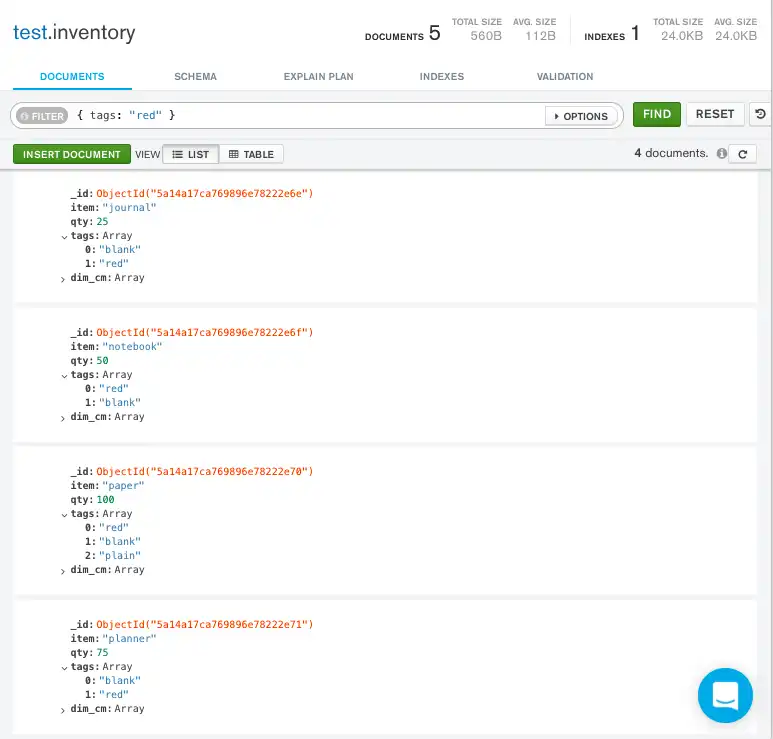
mongoc_collection_t *collection; bson_t *filter; mongoc_cursor_t *cursor; collection = mongoc_database_get_collection (db, "inventory"); filter = BCON_NEW ("tags", BCON_UTF8 ("red")); cursor = mongoc_collection_find_with_opts (collection, filter, NULL, NULL);
var filter = Builders<BsonDocument>.Filter.Eq("tags", "red"); var result = collection.Find(filter).ToList();
cursor, err := coll.Find( context.TODO(), bson.D{ {"tags", "red"}, })
findPublisher = collection.find(eq("tags", "red"));
findIterable = collection.find(eq("tags", "red"));
val findFlow = collection .find(eq("tags", "red"))
cursor = db.inventory.find({"tags": "red"})
const cursor = db.collection('inventory').find({ tags: 'red' });
$cursor = $db->inventory->find(['tags' => 'red']);
cursor = db.inventory.find({"tags": "red"})
client[:inventory].find(tags: 'red')
findObservable = collection.find(equal("tags", "red"))
例如,以下操作将查询所有文档,其中数组 dim_cm 至少包含一个其值大于 25 的元素。
db.inventory.find( { dim_cm: { $gt: 25 } } )
将以下过滤器复制到 Compass 查询栏中,然后单击 Find:
{ dim_cm: { $gt: 25 } }
mongoc_collection_t *collection; bson_t *filter; mongoc_cursor_t *cursor; collection = mongoc_database_get_collection (db, "inventory"); filter = BCON_NEW ( "dim_cm", "{", "$gt", BCON_INT64 (25), "}"); cursor = mongoc_collection_find_with_opts (collection, filter, NULL, NULL);
var filter = Builders<BsonDocument>.Filter.Gt("dim_cm", 25); var result = collection.Find(filter).ToList();
cursor, err := coll.Find( context.TODO(), bson.D{ {"dim_cm", bson.D{ {"$gt", 25}, }}, })
findPublisher = collection.find(gt("dim_cm", 25));
findIterable = collection.find(gt("dim_cm", 25));
val findFlow = collection .find(gt("dim_cm", 25))
cursor = db.inventory.find({"dim_cm": {"$gt": 25}})
const cursor = db.collection('inventory').find({ dim_cm: { $gt: 25 } });
$cursor = $db->inventory->find(['dim_cm' => ['$gt' => 25]]);
cursor = db.inventory.find({"dim_cm": {"$gt": 25}})
client[:inventory].find(dim_cm: { '$gt' => 25 })
findObservable = collection.find(gt("dim_cm", 25))
为数组元素指定多个条件
在用复合条件查询数组中的元素时,您可以设置查询语句,使单个数组元素满足查询条件或是任意数组元素的组合满足查询条件。
通过对数组元素使用复合筛选条件查询数组
以下示例将查询特定文档,其中 dim_cm 数组包含以某种组合形式可满足查询条件的元素;例如,一个元素可满足大于 15 的条件,而另一元素可满足小于 20 的条件,或是单个元素可同时满足这两个条件:
db.inventory.find( { dim_cm: { $gt: 15, $lt: 20 } } )
将以下过滤器复制到 Compass 查询栏中,然后单击 Find:
{ dim_cm: { $gt: 15, $lt: 20 } }
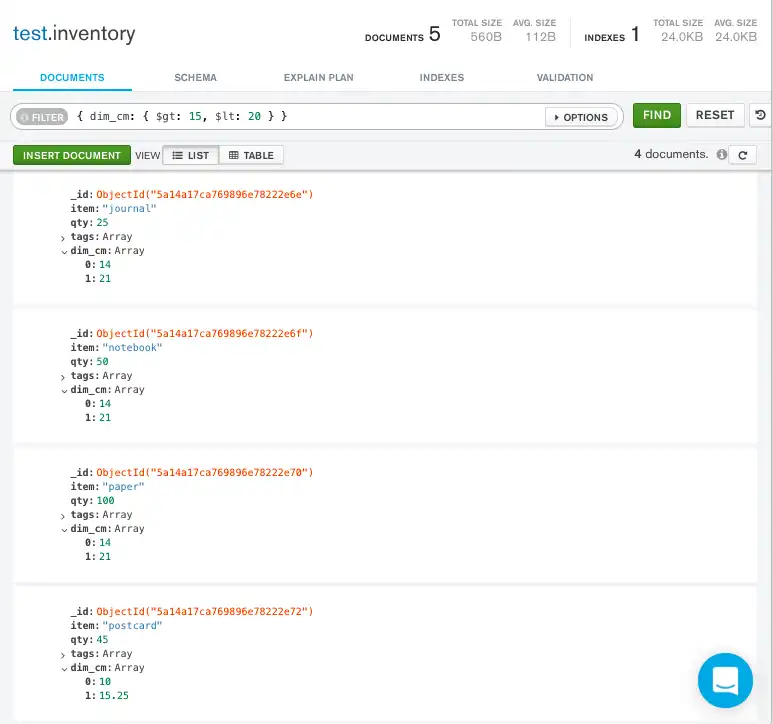
mongoc_collection_t *collection; bson_t *filter; mongoc_cursor_t *cursor; collection = mongoc_database_get_collection (db, "inventory"); filter = BCON_NEW ( "dim_cm", "{", "$gt", BCON_INT64 (15), "$lt", BCON_INT64 (20), "}"); cursor = mongoc_collection_find_with_opts (collection, filter, NULL, NULL);
var builder = Builders<BsonDocument>.Filter; var filter = builder.And(builder.Gt("dim_cm", 15), builder.Lt("dim_cm", 20)); var result = collection.Find(filter).ToList();
cursor, err := coll.Find( context.TODO(), bson.D{ {"dim_cm", bson.D{ {"$gt", 15}, {"$lt", 20}, }}, })
findPublisher = collection.find(and(gt("dim_cm", 15), lt("dim_cm", 20)));
findIterable = collection.find(and(gt("dim_cm", 15), lt("dim_cm", 20)));
val findFlow = collection .find(and(gt("dim_cm", 15), lt("dim_cm", 20)))
cursor = db.inventory.find({"dim_cm": {"$gt": 15, "$lt": 20}})
const cursor = db.collection('inventory').find({ dim_cm: { $gt: 15, $lt: 20 } });
$cursor = $db->inventory->find([ 'dim_cm' => [ '$gt' => 15, '$lt' => 20, ], ]);
cursor = db.inventory.find({"dim_cm": {"$gt": 15, "$lt": 20}})
client[:inventory].find(dim_cm: { '$gt' => 15, '$lt' => 20 })
findObservable = collection.find(and(gt("dim_cm", 15), lt("dim_cm", 20)))
查询满足多个条件的数组元素
使用 $elemMatch 运算符为数组的元素指定多个条件,以使至少一个数组元素满足所有指定的条件。
以下示例将查询特定文档,其中 dim_cm 数组至少包含一个大于 ($gt) 22 且小于 ($lt) 30 的元素:
db.inventory.find( { dim_cm: { $elemMatch: { $gt: 22, $lt: 30 } } } )
将以下过滤器复制到 Compass 查询栏中,然后单击 Find:
{ dim_cm: { $elemMatch: { $gt: 22, $lt: 30 } } }
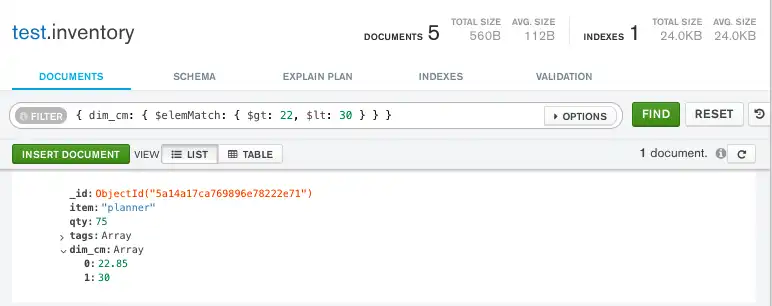
mongoc_collection_t *collection; bson_t *filter; mongoc_cursor_t *cursor; collection = mongoc_database_get_collection (db, "inventory"); filter = BCON_NEW ( "dim_cm", "{", "$elemMatch", "{", "$gt", BCON_INT64 (22), "$lt", BCON_INT64 (30), "}", "}"); cursor = mongoc_collection_find_with_opts (collection, filter, NULL, NULL);
var filter = Builders<BsonDocument>.Filter.ElemMatch<BsonValue>("dim_cm", new BsonDocument { { "$gt", 22 }, { "$lt", 30 } }); var result = collection.Find(filter).ToList();
cursor, err := coll.Find( context.TODO(), bson.D{ {"dim_cm", bson.D{ {"$elemMatch", bson.D{ {"$gt", 22}, {"$lt", 30}, }}, }}, })
findPublisher = collection.find(elemMatch("dim_cm", Document.parse("{ $gt: 22, $lt: 30 }")));
findIterable = collection.find(elemMatch("dim_cm", Document.parse("{ $gt: 22, $lt: 30 }")));
val findFlow = collection .find(elemMatch("dim_cm", Document.parse("{ \$gt: 22, \$lt: 30 }")))
cursor = db.inventory.find({"dim_cm": {"$elemMatch": {"$gt": 22, "$lt": 30}}})
const cursor = db.collection('inventory').find({ dim_cm: { $elemMatch: { $gt: 22, $lt: 30 } } });
$cursor = $db->inventory->find([ 'dim_cm' => [ '$elemMatch' => [ '$gt' => 22, '$lt' => 30, ], ], ]);
cursor = db.inventory.find({"dim_cm": {"$elemMatch": {"$gt": 22, "$lt": 30}}})
client[:inventory].find(dim_cm: { '$elemMatch' => { '$gt' => 22, '$lt' => 30 } })
findObservable = collection.find(elemMatch("dim_cm", Document("$gt" -> 22, "$lt" -> 30)))
按数组索引位置查询元素
使用点符号,可以在数组的特定索引或位置为元素指定查询条件。该数组使用从零开始的索引。
注意
使用点表示法查询时,字段和嵌套字段必须放在引号内。
以下示例将查询所有文档,其中数组 dim_cm 中的第二个元素大于 25:
db.inventory.find( { "dim_cm.1": { $gt: 25 } } )
将以下过滤器复制到 Compass 查询栏中,然后单击 Find:
{ "dim_cm.1": { $gt: 25 } }
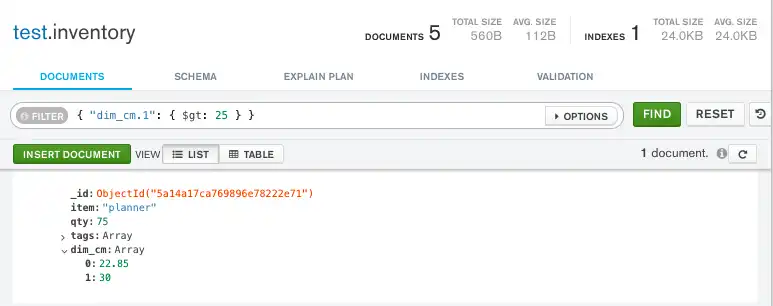
mongoc_collection_t *collection; bson_t *filter; mongoc_cursor_t *cursor; collection = mongoc_database_get_collection (db, "inventory"); filter = BCON_NEW ( "dim_cm.1", "{", "$gt", BCON_INT64 (25), "}"); cursor = mongoc_collection_find_with_opts (collection, filter, NULL, NULL);
var filter = Builders<BsonDocument>.Filter.Gt("dim_cm.1", 25); var result = collection.Find(filter).ToList();
cursor, err := coll.Find( context.TODO(), bson.D{ {"dim_cm.1", bson.D{ {"$gt", 25}, }}, })
findPublisher = collection.find(elemMatch("dim_cm", Document.parse("{ $gt: 22, $lt: 30 }")));
findIterable = collection.find(gt("dim_cm.1", 25));
val findFlow = collection .find(gt("dim_cm.1", 25))
cursor = db.inventory.find({"dim_cm.1": {"$gt": 25}})
const cursor = db.collection('inventory').find({ 'dim_cm.1': { $gt: 25 } });
$cursor = $db->inventory->find(['dim_cm.1' => ['$gt' => 25]]);
cursor = db.inventory.find({"dim_cm.1": {"$gt": 25}})
client[:inventory].find('dim_cm.1' => { '$gt' => 25 })
findObservable = collection.find(gt("dim_cm.1", 25))
按数组长度查询数组
使用 $size 操作符以便按元素个数来查询数组。例如,以下示例会选择数组 tags 有 3 个元素的文档。
db.inventory.find( { "tags": { $size: 3 } } )
将以下过滤器复制到 Compass 查询栏中,然后单击 Find:
{ "tags": { $size: 3 } }
mongoc_collection_t *collection; bson_t *filter; mongoc_cursor_t *cursor; collection = mongoc_database_get_collection (db, "inventory"); filter = BCON_NEW ( "tags", "{", "$size", BCON_INT64 (3), "}"); cursor = mongoc_collection_find_with_opts (collection, filter, NULL, NULL);
根据需要调用以下方法,清理所有打开的资源:
var filter = Builders<BsonDocument>.Filter.Size("tags", 3); var result = collection.Find(filter).ToList();
cursor, err := coll.Find( context.TODO(), bson.D{ {"tags", bson.D{ {"$size", 3}, }}, })
findPublisher = collection.find(size("tags", 3));
findIterable = collection.find(size("tags", 3));
val findFlow = collection .find(size("tags", 3))
cursor = db.inventory.find({"tags": {"$size": 3}})
const cursor = db.collection('inventory').find({ tags: { $size: 3 } });
$cursor = $db->inventory->find(['tags' => ['$size' => 3]]);
cursor = db.inventory.find({"tags": {"$size": 3}})
client[:inventory].find(tags: { '$size' => 3 })
findObservable = collection.find(size("tags", 3))
使用 MongoDB Atlas 查询数组
本部分的示例使用的是示例电影数据集。要了解如何将示例数据集加载到您的 MongoDB Atlas 部署中,请参阅加载示例数据。
要在 MongoDB Atlas 中查询数组,请按照以下步骤操作:
在 MongoDB Atlas 用户界面中,转到您项目的 Clusters(集群)页面。
如果尚未显示,请从导航栏上的 Organizations 菜单中选择包含所需项目的组织。
如果尚未显示,请从导航栏的 Projects 菜单中选择您的项目。
在侧边栏中,单击 Database 标题下的 Clusters。
会显示集群页面。
指定查询筛选文档。
要查询包含数组的文档,请指定查询筛选器文档。 查询筛选器文档使用查询操作符来指定搜索条件。 使用以下示例文档来查询sample_mflix.movies 集合中的大量字段。
要应用查询过滤器,请将示例文档复制到 Filter(过滤器)搜索栏,然后单击 Apply(应用)。
要对数组指定相等条件,请使用查询文档 { <field>: <value> },其中 <value> 是要匹配的精确数组,包括元素的顺序。以下示例查找具有 genres 字段的文档,该字段包含按指定顺序排序的 ["Action", "Comedy"] 数组:
{ genres: ["Action", "Comedy"] }
要查找同时包含 Action 和 Comedy 这两个元素的数组,而不考虑顺序或数组中的其他元素,请使用 $all 操作符:
{ genres: { $all: ["Action", "Comedy"] } }
在用复合条件查询数组中的元素时,您可以设置查询语句,使单个数组元素满足查询条件或是任意数组元素的组合满足查询条件。
通过对数组元素使用复合筛选条件查询数组
下面的示例查询的是 cast 数组包含的元素在某种组合上满足查询条件的文档。例如,以下过滤器使用 $regex 和 $eq 操作符返回单个数组元素以 Olsen 结尾且另一个元素等于 Mary-Kate Olsen 的文档,或者返回同时满足这两个条件的单个元素:
{ cast: { $regex: "Olsen$", $eq: "Mary-Kate Olsen" } }
此查询过滤器返回演员阵容中包含 Mary-Kate Olsen 的电影,以及演员阵容中同时包含 Mary-Kate Olsen 和 Ashley Olsen 的电影。
查询满足多个条件的数组元素
使用 $elemMatch 运算符为数组的元素指定多个条件,以使至少一个数组元素满足所有指定的条件。
以下示例使用 $elemMatch 和 $ne 操作符查询 languages 数组中至少有一个元素既不是 null 也不等于 English 的文档。
{ languages: { $elemMatch: { $ne: null, $ne: "English" } } }
按数组索引位置查询元素
使用点符号,可以在数组的特定索引或位置为元素指定查询条件。该数组使用从零开始的索引。
注意
使用点表示法查询时,字段和嵌套字段必须放在引号内。
以下示例使用 $ne 操作符查询 countries 数组中第一个元素不等于 USA 的所有文档:
{ "countries.0": { $ne: "USA" } }
按数组长度查询数组
使用 $size 操作符以便按元素个数来查询数组。例如,以下示例会选择数组 genres 有 3 个元素的文档。
{ genres: { $size: 3 } }
其他查询教程
有关其他查询示例,请参阅: